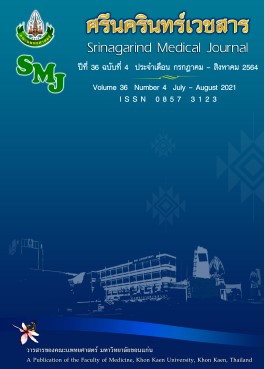การศึกษาเปรียบเทียบอุณหภูมิแกนของผู้ป่วยที่ใช้ Forced-Air Warming ด้วยวิธี Modified Lower-Body Cover กับ Commercial Lower-Body Cover ในระหว่างการผ่าตัดช่องท้องขนาดใหญ่
คำสำคัญ:
อุณหภูมิแกนกายต่ำระหว่างผ่าตัด; ผ้าห่มลมอุ่นประยุกต์; ผ้าห่มลมอุ่นจากบริษัทเวชภัณฑ์; การผ่าตัดช่องท้องขนาดใหญ่บทคัดย่อ
หลักการและวัตถุประสงค์: ภาวะอุณหภูมิแกนกายต่ำระหว่างการผ่าตัดช่องท้องขนาดใหญ่ทำให้เกิดภาวะแทรกซ้อนหลายอย่าง การควบคุมอุณหภูมิให้ได้มาตรฐานยังเป็นสิ่งท้าทาย การใช้เครื่องเป่าลมอุ่นร่วมกับผ้าห่มนั้นมีประสิทธิภาพมาก วัตถุประสงค์เพื่อศึกษาเปรียบเทียบความแตกต่างของอุณหภูมิแกนกายผู้ป่วยระหว่างผ่าตัดในการใช้ผ้าห่มลมอุ่น 2 ชนิด
วิธีการศึกษา: เป็นการศึกษาแบบสุ่มไปข้างหน้าและมีกลุ่มควบคุม ในผู้ป่วยที่เข้ารับการผ่าตัดช่องท้องขนาดใหญ่ ระหว่างเดือนพฤศจิกายน พ.ศ. 2558 ถึงตุลาคม พ.ศ.2559 แบ่งเป็น 2 กลุ่ม กลุ่มละ 20 ราย เปรียบเทียบอุณหภูมิแกนกายในกลุ่มที่ใช้ผ้าห่มลมอุ่นประยุกต์และผ้าห่มลมอุ่นจากบริษัทเวชภัณฑ์ ระหว่างการผ่าตัดสองชั่วโมงแรกโดยใช้ GLM และ repeated-measures ในการวิเคราะห์ข้อมูล
ผลการศึกษา: ข้อมูลพื้นฐานทั้ง 2 กลุ่มไม่แตกต่างกัน ซึ่งอุณหภูมิแกนกายเฉลี่ยระหว่างการผ่าตัดในสองชั่วโมงแรกหลังดมยาสลบ คือ 35.94±0.65 และ 36.18±0.81๐C แตกต่างกัน -0.24 ๐C (95% CI -0.23, 0.71), p=0.313
สรุป: การควบคุมอุณหภูมิแกนกายโดยใช้ผ้าห่มลมอุ่นประยุกต์มีประสิทธิภาพเทียบเท่าผ้าห่มลมอุ่นจากบริษัทเวชภัณฑ์ แต่อย่างไรก็ตามควรศึกษาเพิ่มเติมต่อไป
เอกสารอ้างอิง
2. Connor EL, Wren KR. Detrimental effects of hypothermia: a systems analysis. J Perianesthesia Nurs 2000; 15(3): 151–155.
3. Tedesco NS, Korpi FP, Pazdernik VK, Cochran JM. Relationship between hypothermia and blood loss in adult patients undergoing open lumbar spine surgery. J Am Osteopath Assoc 2014; 114(11): 828–838.
4. Bräuer A, Quintel M. Forced-air warming: technology, physical background and practical aspects. Curr Opin Anaesthesiol 2009; 22(6): 769–774.
5. Torossian A. Thermal management during anaesthesia and thermoregulation standards for the prevention of inadvertent perioperative hypothermia. Best Pract Res Clin Anaesthesiol 2008; 22(4): 659–668.
6. Giesbrecht GG, Ducharme MB, McGuire JP. Comparison of forced-air patient warming systems for perioperative use. Anesthesiology 1994; 80(3): 671–679.
7. Hynson JM, Sessler DI. Intraoperative warming therapies: a comparison of three devices. J Clin Anesth 1992; 4(3): 194–199.
8. Kim EJ, Yoon H. Preoperative factors affecting the intraoperative core body temperature in abdominal surgery under general anesthesia: an observational cohort. Clin Nurse Spec CNS 2014; 28(5): 268–276.
9. Negishi C, Hasegawa K, Mukai S, Nakagawa F, Ozaki M, Sessler DI. Resistive-heating and forced-air warming are comparably effective. Anesth Analg 2003; 96(6): 1683–1687.
10. Kurz A, Kurz M, Poeschl G, Faryniak B, Redl G, Hackl W. Forced-air warming maintains intraoperative normothermia better than circulating-water mattresses. Anesth Analg 1993; 77(1): 89–95.
11. Janicki PK, Higgins MS, Janssen J, Johnson RF, Beattie C. Comparison of two different temperature maintenance strategies during open abdominal surgery: upper body forced-air warming versus whole body water garment. Anesthesiology 2001; 95(4): 868–874.
12. Egan C, Bernstein E, Reddy D, Ali M, Paul J, Yang D, et al. A randomized comparison of intraoperative perfec temp and forced-air warming during open abdominal surgery. Anesth Analg 2011; 113(5): 1076–1081.
13. Thomassen Ø, Færevik H, Østerås Ø, Sunde GA, Zakariassen E, Sandsund M, et al. Comparison of three different prehospital wrapping methods for preventing hypothermia--a crossover study in humans. Scand J Trauma Resusc Emerg Med 2011; 19: 41.
14. Hasegawa K, Negishi C, Nakagawa F, Ozaki M. Core temperatures during major abdominal surgery in patients warmed with new circulating-water garment, forced-air warming, or carbon-fiber resistive-heating system. Best Pract Res Clin Anaesthesiol 2012; 26: 168–173.
15. Ruetzler K, Kovaci B, Güloglu E, Kabon B, Fleischmann E, Kurz A, et al. Forced-air and a novel patient-warming system (vitalHEAT vH2) comparably maintain normothermia during open abdominal surgery. Anesth Analg 2011; 112(3): 608–614.




